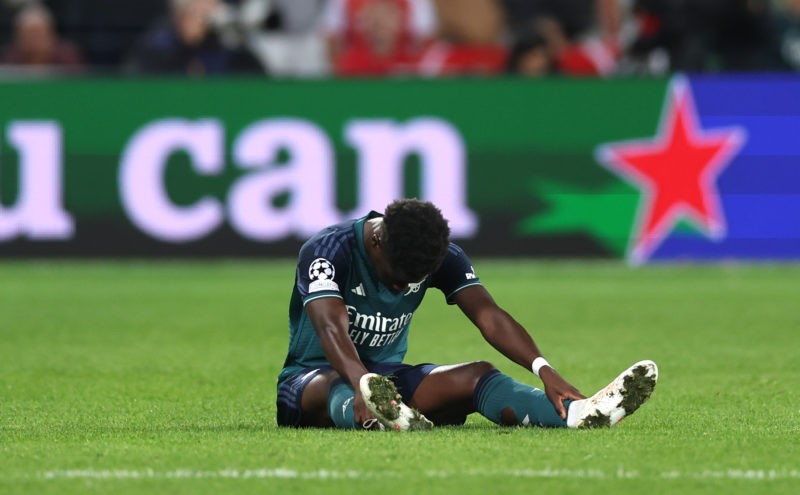The latest injury to Bukayo Saka during Arsenal’s recent clash against RC Lens has triggered alarm bells for fans and team management alike, especially with Manchester City on the horizon.

Mikel Arteta, Arsenal’s manager, insisted after the match that the injury was not related to any previous knocks Saka had sustained.
“He was perfectly fine. He was really looking forward to play,” said Arteta, attributing the injury to a backheel manoeuvre rather than a pre-existing condition. “It wasn’t an action, it was a backheel that can produce that type of injury. Let’s see what the extent of it is.”
Then, in his press conference, Arteta added, “He tried to backheel the ball in the first-half and felt something, it was something muscular and he was uncomfortable to carry on so we had to take him off.
“We don’t know anything more than that, obviously it was big enough not to allow him to continue to play the game and that’s obviously a worry for us.
“I have no clue [if he will be available for City], I don’t know.”
Risk and reward

The Arsenal academy product has been one of the standout performers for the club, averaging a goal involvement in almost every game this season.
While his influence on the pitch is unquestionable, the balancing act between maximising his contributions and ensuring his long-term health remains a growing concern.
Impact on squad depth
The potential loss of Saka comes at a crucial time for Arsenal, who face a high-stakes Premier League match against Manchester City before the international break.
His absence may force Arteta to rethink his attacking options, potentially offering more playing time to the likes of Emile Smith Rowe or Reiss Nelson, who have shown promise but are yet to cement their places in the starting eleven.
Looking ahead
As of now, the full extent of Saka’s injury remains unknown. The club is expected to conduct further medical assessments to ascertain the severity of the issue.
However, this incident is sure to spark discussions within the Arsenal camp about player welfare and workload management, particularly with the demanding schedule that lies ahead.
Understanding hamstring injuries and recovery times in top-level footballers
Hamstring injuries are a common yet tricky issue for top-level footballers, often causing disruption in their playing schedule and requiring meticulous management for effective recovery.
Hamstring injuries explained
A hamstring injury typically involves a strain or tear in the muscles situated at the back of the thigh. These injuries can occur due to various reasons such as rapid acceleration or deceleration, sudden change in direction, or even overuse.
The severity can range from mild strains to complete muscle tears, and the symptoms usually include pain, swelling, and limited leg movement.
Types of hamstring injuries
Hamstring injuries are categorised into three grades:
- Grade 1: Minor muscle pull or strain
- Grade 2: Partial muscle tear
- Grade 3: Complete muscle tear
Recovery times
The recovery timeline varies depending on the grade of the injury:
- Grade 1: Generally takes about 1-3 weeks for recovery. These injuries often require rest and light stretching exercises to aid in healing.
- Grade 2: A more significant injury, taking typically 4-8 weeks for full recovery. The rehabilitation process often includes a combination of physiotherapy, stretching, and strength training exercises.
- Grade 3: Severe cases can take up to 3 months or longer for complete recovery. These instances usually necessitate surgical intervention, followed by an extensive rehabilitation programme.
Implications for top-level footballers
For top-level footballers, even a Grade 1 hamstring injury can result in missing several important matches, while Grades 2 and 3 could potentially sideline a player for a significant portion of the season.
Hamstring injuries are a prevalent issue in football, particularly at the top level where the game’s pace and physicality are higher. Quick and effective treatment coupled with a well-planned rehabilitation programme are crucial for a speedy recovery. This makes the role of a club’s medical team vital in ensuring that players return to full fitness as swiftly as possible.

